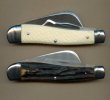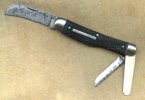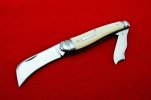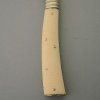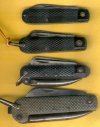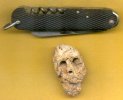waynorth
Knifemaker / Craftsman / Service Provider
- Joined
- Nov 19, 2005
- Messages
- 33,175
Sometimes you can tell the Age, Brand or country of origin of a knife, by the texture on the (usually) bone handles!! Pick-bone often indicates early American cutlery, early 1900s back through late 1800s!! Peachseed jigging is seen from World War eras cutlery! "Flat-Cap" jigging (a modern term) resembles the weave in tweeds, and is found on Sheffield and other UK knives from the turn of the 1900s to the middle 1900s!! That subject can certainly be further discussed beyond my generalizations here!! I invite more knowledgeable people to comment!!
One type of surfacing that is less often seen is Checkering!! You see it on the stocks of many firearms, but more rarely on cutlery, both fixed and folding!! Scratting, an archaic term for "scratching" was used in early Sheffield to improve grip and appearance, and is related to checkering, probably a crude and early form of checkering!!!
Checkering is more often found on custom cutlery, and occasionally on upscale production knives!
Here are some pictures of various forms of the art!!
Modern GEC!!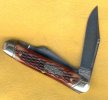
 Queen's version of Sheffield!!
Queen's version of Sheffield!!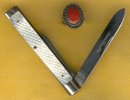 Modern custom!! An Ancient recover by Evan (Esnyx!)!! Quite fine checkering!!
Modern custom!! An Ancient recover by Evan (Esnyx!)!! Quite fine checkering!!
One type of surfacing that is less often seen is Checkering!! You see it on the stocks of many firearms, but more rarely on cutlery, both fixed and folding!! Scratting, an archaic term for "scratching" was used in early Sheffield to improve grip and appearance, and is related to checkering, probably a crude and early form of checkering!!!
Checkering is more often found on custom cutlery, and occasionally on upscale production knives!
Here are some pictures of various forms of the art!!
Modern GEC!!

 Queen's version of Sheffield!!
Queen's version of Sheffield!! Modern custom!! An Ancient recover by Evan (Esnyx!)!! Quite fine checkering!!
Modern custom!! An Ancient recover by Evan (Esnyx!)!! Quite fine checkering!!


